Simulation and Analysis of Water Quality Improvement Measures for Plain River Networks Based on Infoworks ICM Model: Case Study of Baoying County, China
Abstract
:1. Introduction
2. Materials and Methods
2.1. Investigation of the Study Area
2.2. Data Collection
2.3. Methods
2.3.1. Construction of Hydraulic Model
2.3.2. Construction of Water Quality Model
2.3.3. Model Boundary
2.3.4. Model Calibration
3. Results and Discussion
3.1. Current Status of Pollution Sources
3.2. Analysis of Unstable Water Quality Compliance
3.3. Analysis of Pollution Source Load
3.4. Results
3.5. Improvement Measures
3.5.1. Low-Impact Development (LID)
- Ten per cent of green space was converted into bioretention basins, and 50 per cent of surface runoff was directed from impervious surfaces into bioretention basins for runoff and pollution control.
- Ten per cent of green space was converted into rain gardens, and 30 per cent of surface runoff was directed from impervious surfaces into rain gardens.
- Twenty per cent of green space was converted into grassed swales to act in the diversion and transfer of surface runoff.
- The remaining 20% of impervious surface runoff was not controlled by sponge facilities and was discharged directly into the stormwater network.
3.5.2. Reducing Fertiliser Application
3.5.3. Reduction of Direct Rural Domestic Sewage Discharge
3.5.4. Ecological Floating Islands and Artificial Aeration
3.5.5. Synergy of All Measures
4. Conclusions
Supplementary Materials
Author Contributions
Funding
Data Availability Statement
Conflicts of Interest
References
- Cui, Y.; Zhou, Y.; Jin, J.; Zhang, L.; Wu, C.; Ning, S. Coordinated development evaluation and diagnosis of regional water resources-social economy-ecological environment system based on mechanical model and risk matrix. J. Hydrol. 2024, 633, 131013. [Google Scholar] [CrossRef]
- Zhou, R.; Jin, J.; Wu, C.; Zhou, L.; Zhang, L.; Cui, Y.; Zhang, Y.; Zhou, Y. Connection number-based model for coordination development evaluation of regional water resources, social economy and ecological environment complex system. J. Environ. Manag. 2023, 339, 117913. [Google Scholar] [CrossRef] [PubMed]
- Zhou, J.-R.; Li, X.-Q.; Yu, X.; Zhao, T.-C.; Ruan, W.-X. Exploring the ecological security evaluation of water resources in the Yangtze River Basin under the background of ecological sustainable development. Sci. Rep. 2024, 14, 15475. [Google Scholar] [CrossRef] [PubMed]
- Scanlon, B.R.; Fakhreddine, S.; Rateb, A.; de Graaf, I.; Famiglietti, J.; Gleeson, T.; Grafton, R.Q.; Jobbagy, E.; Kebede, S.; Kolusu, S.R.; et al. Global water resources and the role of groundwater in a resilient water future. Nat. Rev. Earth Environ. 2023, 4, 87–101. [Google Scholar] [CrossRef]
- Kalogiannidis, S.; Kalfas, D.; Giannarakis, G.; Paschalidou, M. Integration of Water Resources Management Strategies in Land Use Planning towards Environmental Conservation. Sustainability 2023, 15, 15242. [Google Scholar] [CrossRef]
- Obin, N.; Tao, H.; Ge, F.; Liu, X. Research on Water Quality Simulation and Water Environmental Capacity in Lushui River Based on WASP Model. Water 2021, 13, 2819. [Google Scholar] [CrossRef]
- Mummidivarapu, S.K.; Rehana, S.; Singh, H. Application of QUAL2K Model for Water Quality Modeling of Bhadra River Stretch, India. In Fluid Mechanics and Hydraulics; Timbadiya, P.V., Patel, P.L., Singh, V.P., Barman, B., Eds.; Springer Nature: Singapore, 2023; pp. 567–579. [Google Scholar] [CrossRef]
- Seifi, A.; Dehghani, M.; Singh, V.P. Uncertainty analysis of water quality index (WQI) for groundwater quality evaluation: Application of Monte-Carlo method for weight allocation. Ecol. Indic. 2020, 117, 106653. [Google Scholar] [CrossRef]
- Zhou, J.; Pang, Y.; Wang, H.; Li, W.; Liu, J.; Luo, Z.; Shao, W.; Zhang, H. Sewage network operational risks based on InfoWorks ICM with nodal flow diurnal patterns under NPIs for COVID-19. Water Res. 2023, 246, 120708. [Google Scholar] [CrossRef]
- Żelazny, M.; Bryła, M.; Ozga-Zielinski, B.; Walczykiewicz, T. Applicability of the WASP Model in an Assessment of the Impact of Anthropogenic Pollution on Water Quality—Dunajec River Case Study. Sustainability 2023, 15, 2444. [Google Scholar] [CrossRef]
- Ji, K.; Li, W.; Hao, X.; Ouyang, W.; Zhang, Y. Transport dynamics of watershed discharged diffuse phosphorus pollution load to the lake in middle of Yangtze River Basin. Environ. Pollut. 2024, 344, 123221. [Google Scholar] [CrossRef]
- Mummidivarapu, S.K.; Rehana, S.; Rao, Y.R.S. Mapping and assessment of river water quality under varying hydro-climatic and pollution scenarios by integrating QUAL2K, GEFC, and GIS. Environ. Res. 2023, 239, 117250. [Google Scholar] [CrossRef] [PubMed]
- Fleming, P.M.; Stephenson, K.; Collick, A.S.; Easton, Z.M. Targeting for nonpoint source pollution reduction: A synthesis of lessons learned, remaining challenges, and emerging opportunities. J. Environ. Manag. 2022, 308, 114649. [Google Scholar] [CrossRef] [PubMed]
- Yang, X.; Chen, Z. A hybrid approach based on Monte Carlo simulation-VIKOR method for water quality assessment. Ecol. Indic. 2023, 150, 110202. [Google Scholar] [CrossRef]
- Tiyasha; Tung, T.M.; Yaseen, Z.M. A survey on river water quality modelling using artificial intelligence models: 2000–2020. J. Hydrol. 2020, 585, 124670. [Google Scholar] [CrossRef]
- England, J.; Angelopoulos, N.; Cooksley, S.; Dodd, J.; Gill, A.; Gilvear, D.; Johnson, M.; Naura, M.; O’Hare, M.; Tree, A.; et al. Best Practices for Monitoring and Assessing the Ecological Response to River Restoration. Water 2021, 13, 3352. [Google Scholar] [CrossRef]
- Song, W.; Wang, S.; Zhao, J.; Xu, S.; Zhou, X.; Zhang, Y. Comprehensive Treatment for River Pollution in a Coastal City with a Complex River Network: A Case Study in Sanya, China. Sustainability 2023, 15, 6830. [Google Scholar] [CrossRef]
- Wu, W.; Lu, L.; Huang, X.; Shangguan, H.; Wei, Z. An automatic calibration framework based on the InfoWorks ICM model: The effect of multiple objectives during multiple water pollutant modeling. Environ. Sci. Pollut. Res. 2021, 28, 31814–31830. [Google Scholar] [CrossRef]
- Bertrand, N.; Abily, M.; Lambert, M.; Delestre, O. Benefit of Coupling 1D-2D Model Over an Urban Area to Assess Runoff During a Storm Event. In Advances in Hydroinformatics; Gourbesville, P., Caignaert, G., Eds.; Springer Nature: Singapore, 2022; pp. 315–328. [Google Scholar] [CrossRef]
- Zhang, R.; Li, Y.; Chen, T.; Zhou, L. Flood risk identification in high-density urban areas of Macau based on disaster scenario simulation. Int. J. Disaster Risk Reduct. 2024, 107, 104485. [Google Scholar] [CrossRef]
- Agonafir, C.; Lakhankar, T.; Khanbilvardi, R.; Krakauer, N.; Radell, D.; Devineni, N. A review of recent advances in urban flood research. Water Secur. 2023, 19, 100141. [Google Scholar] [CrossRef]
- Jin, X.; Zhou, P.; Zhang, X.; Liu, C. A coupling 1D-2D model of urban flooding simulation based on improved vertical flow exchange method. Adv. Water Sci. 2023, 34, 218–226. [Google Scholar] [CrossRef]
- Li, Y.; Wang, H.; Deng, Y.; Liang, D.; Li, Y.; Gu, Q. Applying water environment capacity to assess the non-point source pollution risks in watersheds. Water Res. 2023, 240, 120092. [Google Scholar] [CrossRef] [PubMed]
- Anh, N.T.; Can, L.D.; Nhan, N.T.; Schmalz, B.; Luu, T.L. Influences of key factors on river water quality in urban and rural areas: A review. Case Stud. Chem. Environ. Eng. 2023, 8, 100424. [Google Scholar] [CrossRef]
- Wu, R.; Zhang, S.; Liu, Y.; Shi, X.; Zhao, S.; Kang, X.; Quan, D.; Sun, B.; Arvola, L.; Li, G. Spatiotemporal variation in water quality and identification and quantification of areas sensitive to water quality in Hulun lake, China. Ecol. Indic. 2023, 149, 110176. [Google Scholar] [CrossRef]
- GB3838-2002; Environmental Quality Standards for Surface Water. Ministry of Ecology and Environment, The People’s Republic of China: Beijing, China, 2002. Available online: https://big5.mee.gov.cn/gate/big5/www.mee.gov.cn/ywgz/fgbz/bz/bzwb/shjbh/shjzlbz/200206/t20020601_66497.shtml (accessed on 18 September 2024).
- Shin, S.; Her, Y.; Muñoz-Carpena, R.; Khare, Y.P. Multi-parameter approaches for improved ensemble prediction accuracy in hydrology and water quality modeling. J. Hydrol. 2023, 622, 129458. [Google Scholar] [CrossRef]
- Wang, M.; Duan, L.; Bai, Y.; Peng, J.; Wang, Y.; Zheng, B. Improved export coefficient model for identification of watershed environmental risk areas. Environ. Sci. Pollut. Res. 2023, 30, 34649–34668. [Google Scholar] [CrossRef]
- An, S.; Song, Y.; Fu, Q.; Qi, R.; Wu, Z.; Ge, F.; Lu, X.; An, W.; Han, W. Reclaimed water use improved polluted water’s self-purification capacity --Evidenced by water quality factors and bacterial community structure. J. Clean. Prod. 2023, 386, 135736. [Google Scholar] [CrossRef]
- Zhang, J.; Jiang, Y.; Zhang, H.; Feng, D.; Bu, H.; Li, L.; Lu, S. A critical review of characteristics of domestic wastewater and key treatment techniques in Chinese villages. Sci. Total Environ. 2024, 927, 172155. [Google Scholar] [CrossRef]
- Yang, G.; Pan, H.; Lei, H.; Tong, W.; Shi, L.; Chen, H. Dissolved organic matter evolution and straw decomposition rate characterization under different water and fertilizer conditions based on three-dimensional fluorescence spectrum and deep learning. J. Environ. Manag. 2023, 344, 118537. [Google Scholar] [CrossRef]
- Marin, E.; Rusănescu, C.O. Agricultural Use of Urban Sewage Sludge from the Wastewater Station in the Municipality of Alexandria in Romania. Water 2023, 15, 458. [Google Scholar] [CrossRef]
- Cao, Q.; Cao, J.; Xu, R. Optimizing Low Impact Development for Stormwater Runoff Treatment: A Case Study in Yixing, China. Water 2023, 15, 989. [Google Scholar] [CrossRef]
- Nazari, A.; Roozbahani, A.; Shahdany, S.M.H. Integrated SUSTAIN-SWMM-MCDM Approach for Optimal Selection of LID Practices in Urban Stormwater Systems. Water Resour. Manag. 2023, 37, 3769–3793. [Google Scholar] [CrossRef]
- Han, J.; Wang, C.; Deng, S.; Lichtfouse, E. China’s sponge cities alleviate urban flooding and water shortage: A review. Environ. Chem. Lett. 2023, 21, 1297–1314. [Google Scholar] [CrossRef]
- Nazarpour, S.; Gnecco, I.; Palla, A. Evaluating the Effectiveness of Bioretention Cells for Urban Stormwater Management: A Systematic Review. Water 2023, 15, 913. [Google Scholar] [CrossRef]
- Zamani, M.G.; Saniei, K.; Nematollahi, B.; Zahmatkesh, Z.; Poor, M.M.; Nikoo, M.R. Developing sustainable strategies by LID optimization in response to annual climate change impacts. J. Clean. Prod. 2023, 416, 137931. [Google Scholar] [CrossRef]
- Wang, J.; Zhou, X.; Wang, S.; Chen, L.; Shen, Z. Simulation and Comprehensive Evaluation of the Multidimensional Environmental Benefits of Sponge Cities. Water 2023, 15, 2590. [Google Scholar] [CrossRef]
- Hou, Y.; Wang, S.; Ma, Y.; Shen, Z.; Goonetilleke, A. Influence of landscape patterns on nitrate and particulate organic nitrogen inputs to urban stormwater runoff. J. Environ. Manag. 2023, 348, 119190. [Google Scholar] [CrossRef]
- Wang, L.; Lu, P.; Feng, S.; Hamel, C.; Sun, D.; Siddique, K.H.M.; Gan, G.Y. Strategies to improve soil health by optimizing the plant–soil–microbe–anthropogenic activity nexus, Agriculture. Ecosyst. Environ. 2024, 359, 108750. [Google Scholar] [CrossRef]
- Ahmed, A.A.Q.; McKay, T.J.M. Environmental and ecological importance of bacterial extracellular vesicles (BEVs). Sci. Total Environ. 2024, 907, 168098. [Google Scholar] [CrossRef]
- Sheikh, M.; Harami, H.R.; Rezakazemi, M.; Cortina, J.L.; Aminabhavi, T.M.; Valderrama, C. Towards a sustainable transformation of municipal wastewater treatment plants into biofactories using advanced NH3-N recovery technologies: A review. Sci. Total Environ. 2023, 904, 166077. [Google Scholar] [CrossRef]
- Wang, Y.; Liang, L.; Liu, J.; Guo, D.; Zhu, Z.; Dong, H. Impact of anaerobic digestion on reactive nitrogen gas emissions from dairy slurry storage. J. Environ. Manag. 2022, 316, 115306. [Google Scholar] [CrossRef]
- Magrí, A.; Carreras-Sempere, M.; Biel, C.; Colprim, J. Recovery of Phosphorus from Waste Water Profiting from Biological Nitrogen Treatment: Upstream, Concomitant or Downstream Precipitation Alternatives. Agronomy 2020, 10, 1039. [Google Scholar] [CrossRef]
- Estahbanati, M.R.K.; Kumar, S.; Khajvand, M.; Drogui, P.; Tyagi, R.D. Wastewater. In Biomass, Biofuels, Biochemicals; Pandey, A., Tyagi, R.D., Varjani, S., Eds.; Elsevier: Amsterdam, The Netherlands, 2021; pp. 121–162. [Google Scholar] [CrossRef]
- Luo, P.; Xin, C.; Zhu, Y.; Liu, Y.; Ling, J.; Wang, T.; Huang, J.; Khu, S.-T. Effect of Rational Fertilizer for Eggplants on Nitrogen and Phosphorus Pollutants in Agricultural Water Bodies. Processes 2023, 11, 579. [Google Scholar] [CrossRef]
- Xiao, Y.; Zhang, C.; Zhang, T.; Luan, B.; Liu, J.; Zhou, Q.; Li, C.; Cheng, H. Transport processes of dissolved and particulate nitrogen and phosphorus over urban road surface during rainfall runoff. Sci. Total Environ. 2024, 948, 174905. [Google Scholar] [CrossRef]
- Sahu, A.K.; Mir, S.; Nayak, B.; Baitharu, I. Chapter 13—Sustainable management of eutrophication and problems associated with the algal toxin in ponds and lakes of rural areas. In Water Resources Management for Rural Development; Madhav, S., Srivastav, A.L., Izah, S.C., Hullebusch, E.V., Eds.; Elsevier: Amsterdam, The Netherlands, 2024; pp. 155–170. [Google Scholar] [CrossRef]
- Chakrabarty, S. Factors Leading to Disposal of Toxic and Hazardous Sacred Waste and Its Effect on Urban River Contamination: Case of Adi Ganga, Kolkata, India. In Perception, Design and Ecology of the Built Environment: A Focus on the Global South; Ghosh, M., Ed.; Springer International Publishing: Cham, Switzerland, 2020; pp. 183–263. [Google Scholar] [CrossRef]
- Xia, Y.; Zhang, M.; Tsang, D.C.W.; Geng, N.; Lu, D.; Zhu, L.; Igalavithana, A.D.; Dissanayake, P.D.; Rinklebe, J.; Yang, X.; et al. Recent advances in control technologies for non-point source pollution with nitrogen and phosphorous from agricultural runoff: Current practices and future prospects. Appl. Biol. Chem. 2020, 63, 8. [Google Scholar] [CrossRef]
- Qiao, P.; Wang, S.; Li, J.; Zhao, Q.; Wei, Y.; Lei, M.; Yang, J.; Zhang, Z. Process; influencing factors, and simulation of the lateral transport of heavy metals in surface runoff in a mining area driven by rainfall: A review. Sci. Total Environ. 2023, 857, 159119. [Google Scholar] [CrossRef]
- Wu, H.; Wang, R.; Yan, P.; Wu, S.; Chen, Z.; Zhao, Y.; Cheng, C.; Hu, Z.; Zhuang, L.; Guo, Z.; et al. Constructed wetlands for pollution control. Nat. Rev. Earth Environ. 2023, 4, 218–234. [Google Scholar] [CrossRef]
- Qin, S.; Zhong, M.; Lin, B.; Zhang, Q. Roles of Floating Islands in Aqueous Environment Remediation: Water Purification and Urban Aesthetics. Water 2023, 15, 1134. [Google Scholar] [CrossRef]
- Allen, D.J.; Huang, J.; Farrell, M.; Mosley, L.M. Novel insight into ammonium, phosphate, and iron(II) dynamics in the sediment porewater of a constructed wetland under artificial aeration through the diffusive equilibrium in thin films technique. Environ. Res. 2023, 236, 116746. [Google Scholar] [CrossRef]
- Zhong, L.; Ding, J.; Wu, T.; Zhao, Y.-L.; Pang, J.W.; Jiang, J.-P.; Jiang, J.-Q.; Li, Y.; Ren, N.-Q.; Yang, S.-S. Bibliometric overview of research progress, challenges, and prospects of rural domestic sewage: Treatment techniques, resource recovery, and ecological risk. J. Water Process Eng. 2023, 51, 103389. [Google Scholar] [CrossRef]
- Chen, L.; Guo, C.; Yu, Y.; Zhou, X.; Fu, Y.; Wang, S.; Ma, Y.; Shen, Z. Optimization of green infrastructures for sustaining urban stormwater quality and quantity: An integrated resilience evaluation. J. Hydrol. 2024, 640, 131682. [Google Scholar] [CrossRef]
- Hassan, F.; Prasetya, K.D.; Hanun, J.N.; Bui, H.M.; Rajendran, S.; Kataria, N.; Khoo, K.S.; Wang, Y.-F.; You, S.-J.; Jiang, J.-J. Microplastic contamination in sewage sludge: Abundance, characteristics, and impacts on the environment and human health. Environ. Technol. Innov. 2023, 31, 103176. [Google Scholar] [CrossRef]
- Peng, Z.-X.; He, Y.; Yu, L.-J.; Hao, Z.-Y.; Li, T.-M.; Gu, L.-K.; Wang, L. The influence of in situ purification system on pathogen in the river fed by the drainage of sewage plant. Environ. Sci. Pollut. Res. 2024, 31, 29930–29938. [Google Scholar] [CrossRef] [PubMed]
- Wang, M.; Jiang, T.; Mao, Y.; Wang, F.; Yu, J.; Zhu, C. Current Situation of Agricultural Non-Point Source Pollution and Its Control. Water Air Soil Pollut. 2023, 234, 471. [Google Scholar] [CrossRef]
- Chen, F.; Huang, T.; Wen, G.; Li, K. Impact of artificial mixing and oxygenation on bacteria in a water transfer reservoir: Community succession and the role in water quality improvement. Sci. Total Environ. 2024, 908, 168581. [Google Scholar] [CrossRef]
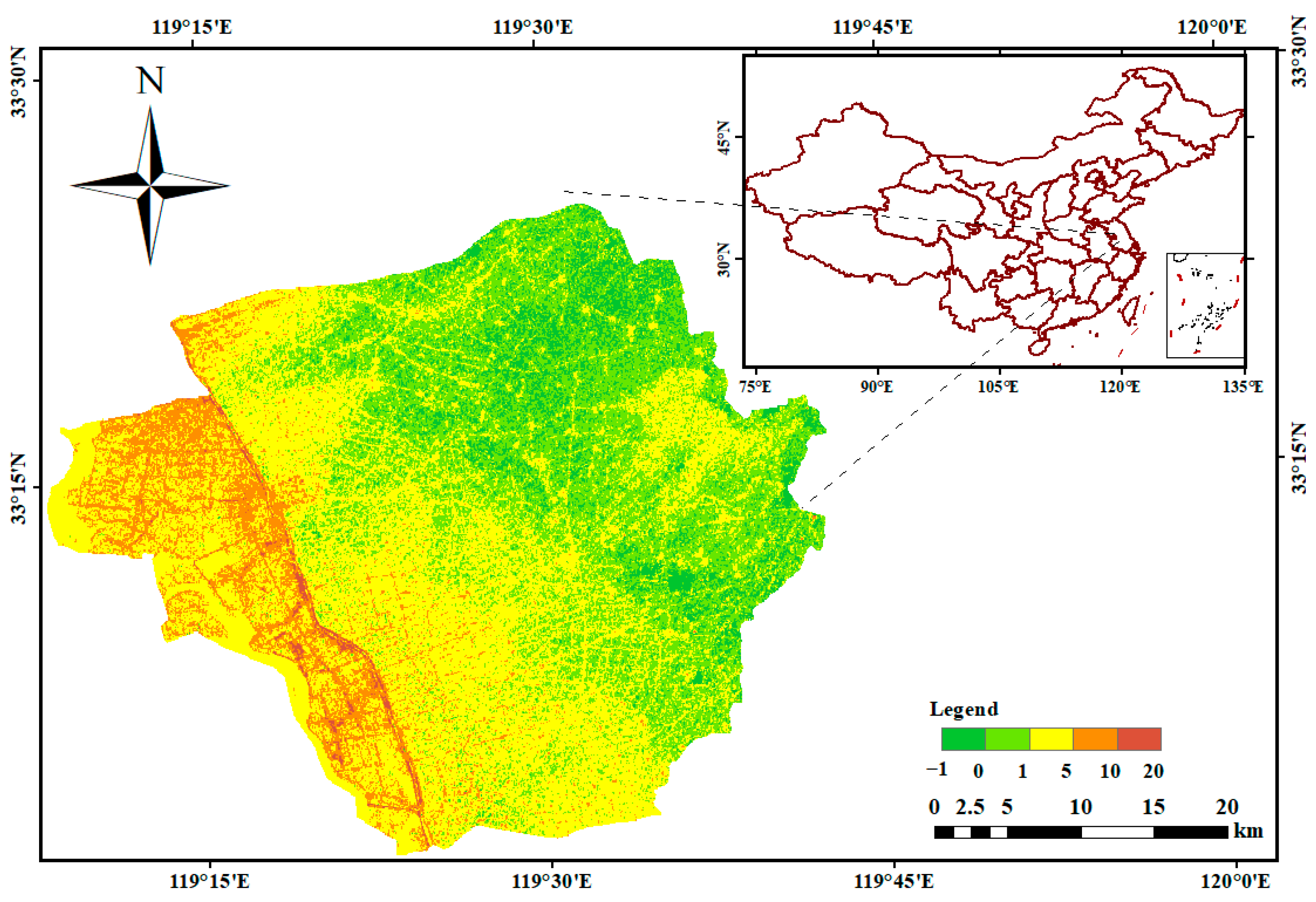

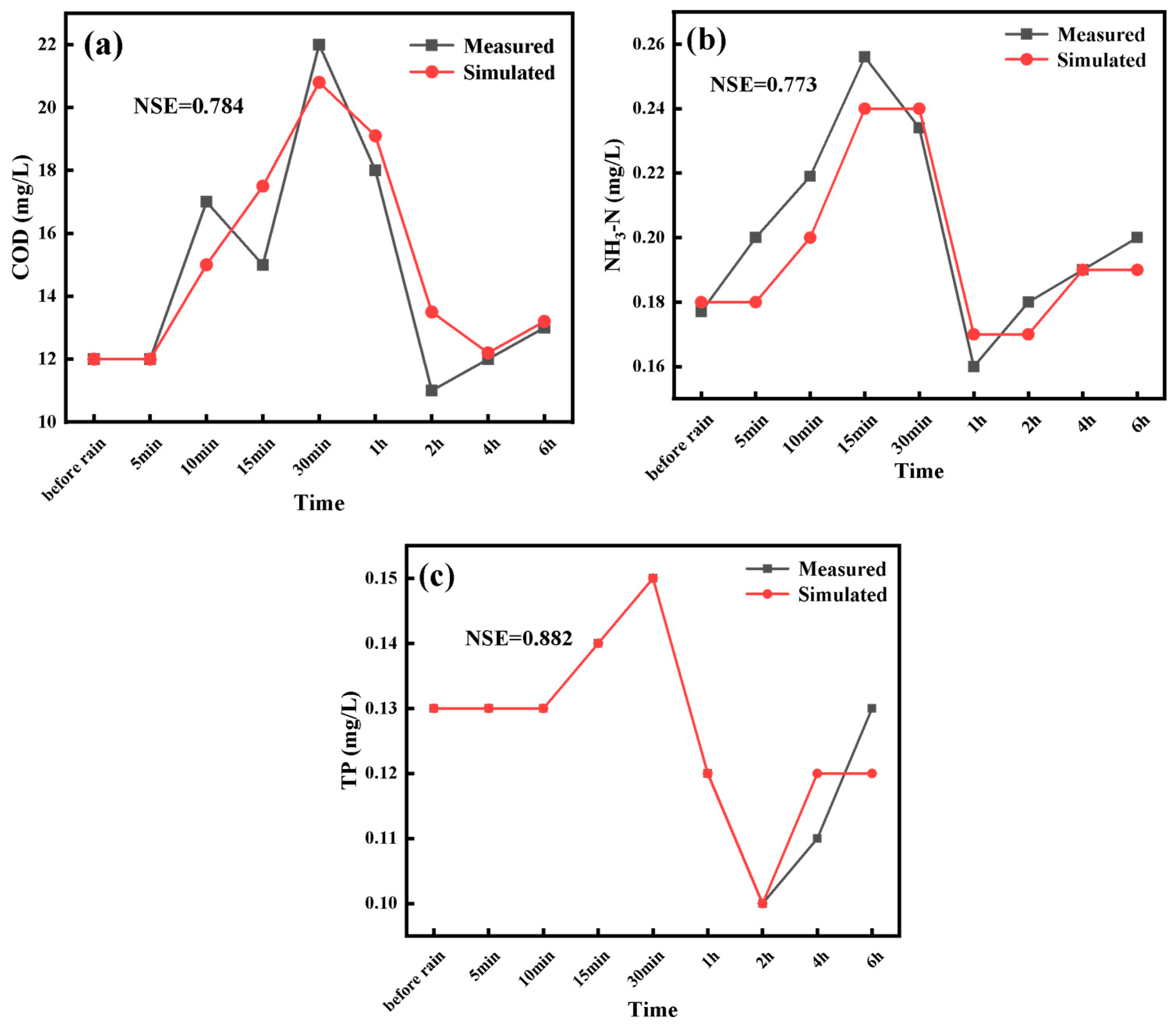
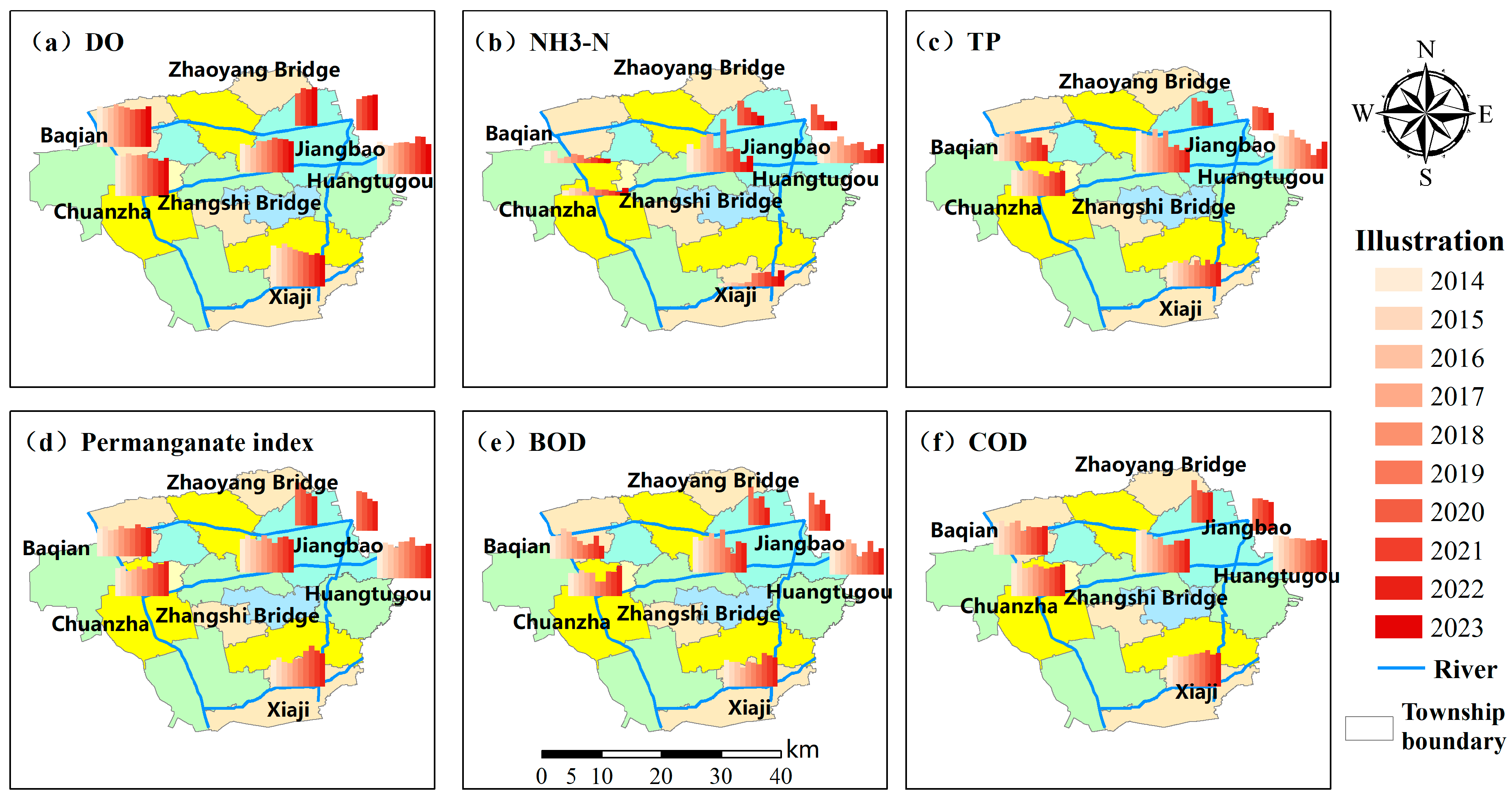


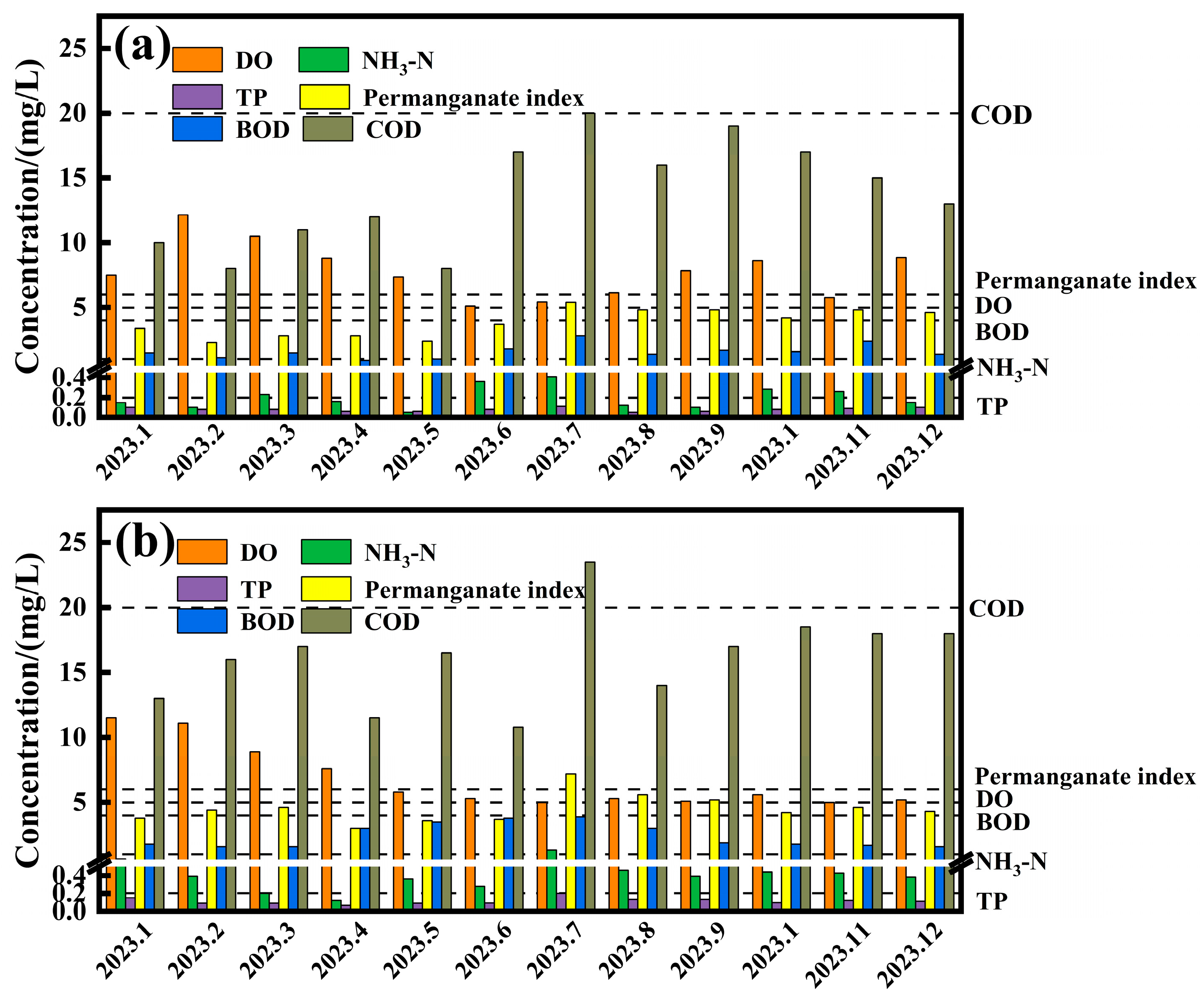
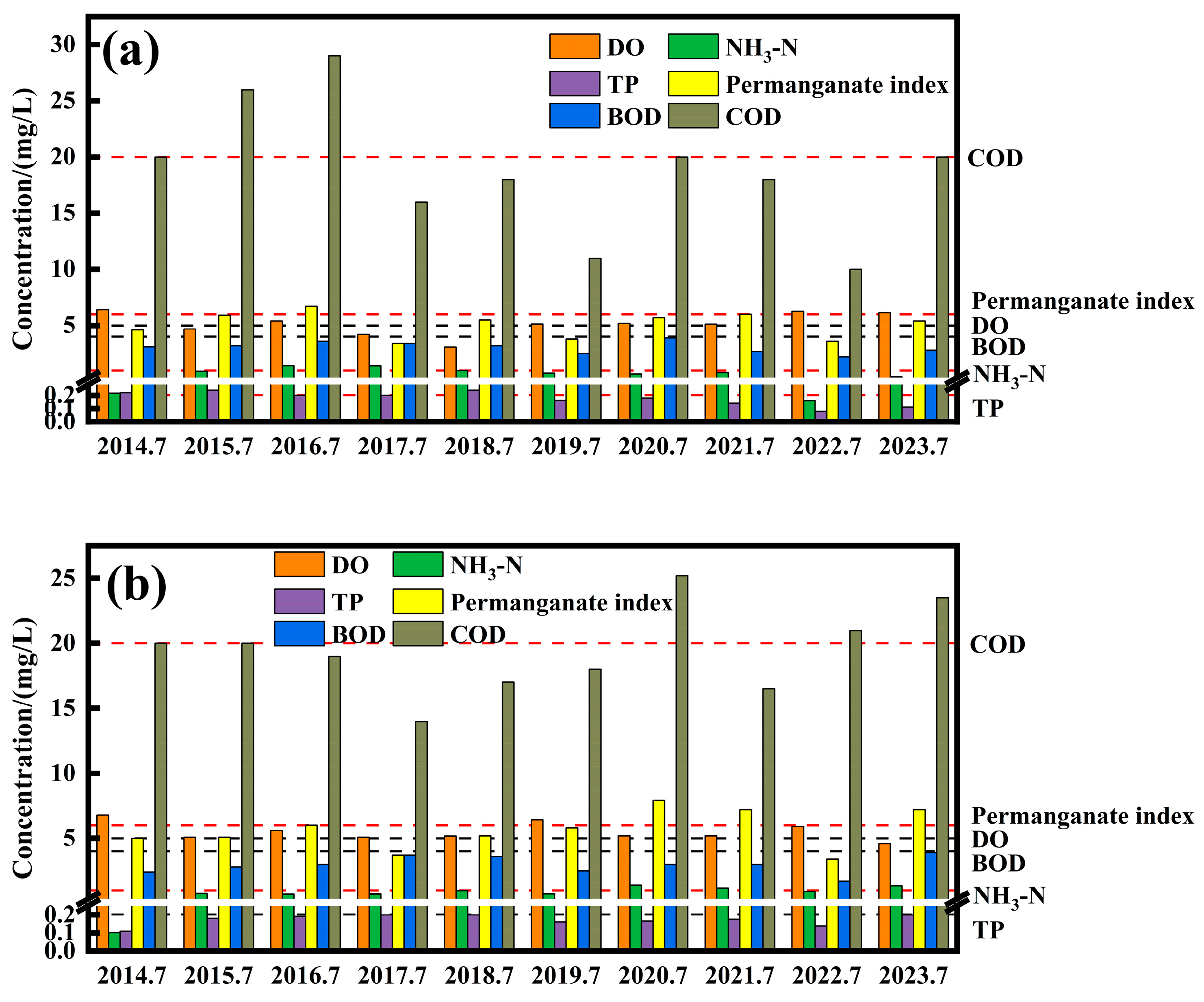
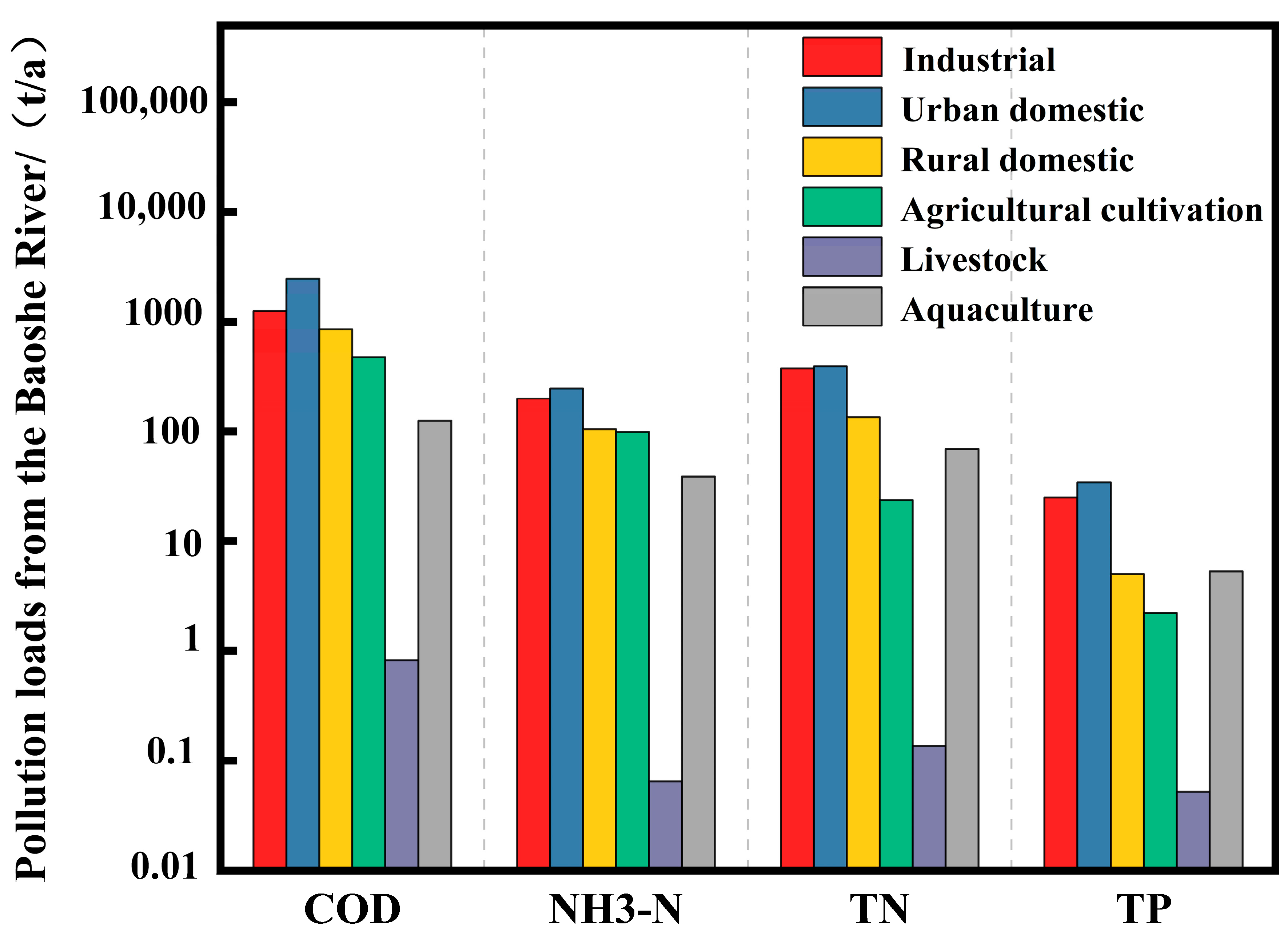





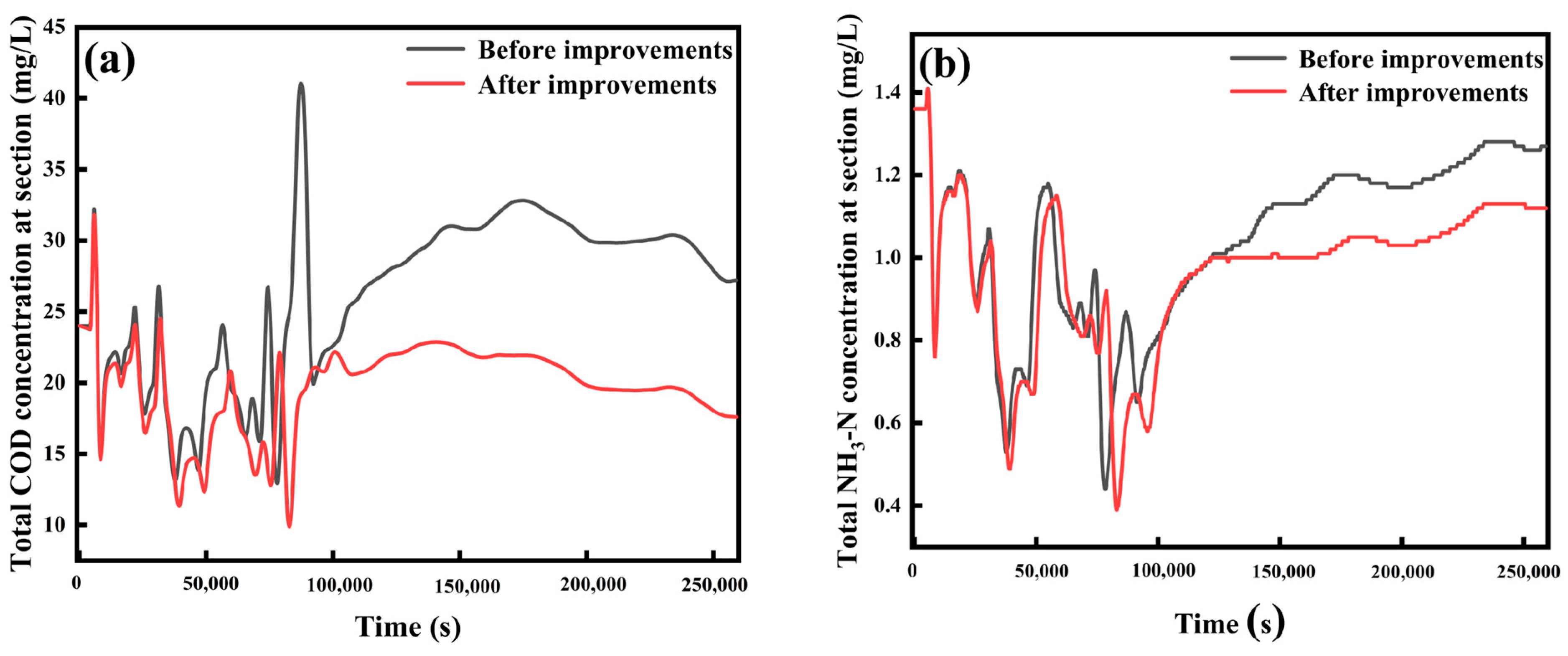
| No. | Control Units | Section Name | Section Location |
|---|---|---|---|
| 1 | The Grand Canal (Baoying Section) | Baqian | 119.28, 33.27 |
| 2 | The Grand Canal (Baoying Section) | Chuanzha | 119.31, 33.22 |
| 3 | Baoshe River | Zhangshi Bridge | 119.49, 33.25 |
| 4 | Baoshe River | Huangtugou | 119.69, 33.29 |
| 5 | Datong River | Xiaji | 119.54, 33.08 |
| 6 | Daxi River | Chaoyang Bridge | 119.58, 33.33 |
| 7 | Dasanwang River | Jiangbao village | 119.62, 33.32 |
| No. | Tributary | COD (mg/L) | NH3-N (mg/L) | TP (mg/L) | Permanganate Index (mg/L) | Exceedance Factors |
|---|---|---|---|---|---|---|
| 1 | Wangzhi | 14 | 0.938 | 0.15 | 4.2 | / |
| 2 | Zhongpai | 11 | 2.50 | 0.11 | 4.2 | NH3-N |
| 3 | Daguan | 13 | 1.85 | 0.12 | 5.2 | NH3-N |
| 4 | Suzhuang | 14 | 1.07 | 0.08 | 5.1 | NH3-N |
| 5 | Dalu | 11 | 1.92 | 0.10 | 4.4 | NH3-N |
| 6 | Qianjin | 11 | 1.68 | 0.13 | 4.4 | NH3-N |
| 7 | Xidang | 15 | 0.366 | 0.14 | 4.1 | / |
| 8 | Huyang | 12 | 2.02 | 0.10 | 4.3 | NH3-N |
| 9 | Zhangshidang | 14 | 1.36 | 0.09 | 4.1 | NH3-N |
| 10 | Yingsha | 13 | 1.75 | 0.19 | 5.0 | NH3-N |
| 11 | Nanchang | 24 | 0.322 | 0.44 | 7.8 | COD, TP, permanganate index |
| Class III water quality standard (GB3838-2002) [26] | 20 | 1 | 0.2 | 6 | ||
Disclaimer/Publisher’s Note: The statements, opinions and data contained in all publications are solely those of the individual author(s) and contributor(s) and not of MDPI and/or the editor(s). MDPI and/or the editor(s) disclaim responsibility for any injury to people or property resulting from any ideas, methods, instructions or products referred to in the content. |
© 2024 by the authors. Licensee MDPI, Basel, Switzerland. This article is an open access article distributed under the terms and conditions of the Creative Commons Attribution (CC BY) license (https://creativecommons.org/licenses/by/4.0/).
Share and Cite
Zhu, Q.; Fang, K.; Zhu, D.; Li, X.; Chen, X.; Han, S.; Chen, F.; Gao, C.; Sun, J.; Tang, R.; et al. Simulation and Analysis of Water Quality Improvement Measures for Plain River Networks Based on Infoworks ICM Model: Case Study of Baoying County, China. Water 2024, 16, 2698. https://doi.org/10.3390/w16182698
Zhu Q, Fang K, Zhu D, Li X, Chen X, Han S, Chen F, Gao C, Sun J, Tang R, et al. Simulation and Analysis of Water Quality Improvement Measures for Plain River Networks Based on Infoworks ICM Model: Case Study of Baoying County, China. Water. 2024; 16(18):2698. https://doi.org/10.3390/w16182698
Chicago/Turabian StyleZhu, Qiande, Kaibin Fang, Dexun Zhu, Xinran Li, Xiaoyu Chen, Song Han, Feng Chen, Chuang Gao, Jun Sun, RongJie Tang, and et al. 2024. "Simulation and Analysis of Water Quality Improvement Measures for Plain River Networks Based on Infoworks ICM Model: Case Study of Baoying County, China" Water 16, no. 18: 2698. https://doi.org/10.3390/w16182698






